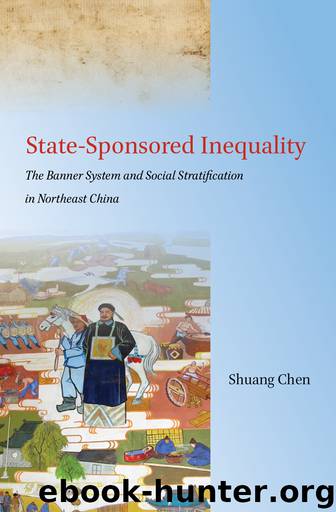State-Sponsored Inequality by Shuang Chen

Author:Shuang Chen [Chen, Shuang]
Language: eng
Format: epub
Publisher: Stanford University Press
Published: 2017-03-14T16:00:00+00:00
CHAPTER SEVEN
Sustaining Hierarchy
Wealth Stratification
When talking about wealth stratification in historical China, people usually reference two influential sayings: “the rich have large fields connected by crisscross paths, and the poor do not even have enough land to stick an awl into” (fuzhe tian lian qianmo, pin zhe wu lizhui zhidi) and “from rags to riches and back in three generations.”1 The first saying depicts an extreme situation of land concentration. In the second century BC, an official named Dong Zhongshu (179–104 BC) used this rhetoric to illustrate the consequences of the privatization and the free transaction of land (HS, book 4, 1137). His purpose was to persuade the emperor of the Western Han (202 BC–AD 8) to enforce state control of land and maintain equal land distribution among commoners, because maintaining equal land distribution and ensuring a large base population that paid taxes and provided labor services was crucial to the dynasty’s rule. The second saying illustrates a society with dramatically fluctuating wealth mobility. Together, these sayings summarize two assumptions about the outcomes of a totally free land market—volatility and inequality: the distribution of landed wealth was highly unequal at both the national and community levels, and the wealth statuses of individual families was unstable.
For centuries, these two sayings have influenced people’s understanding of political economy and wealth stratification in premodern and early modern China. The central government’s power always faced competition from wealthy landowners, who tended to accumulate large amounts of land and to control the population working on it (He 1956, 1958). The transition from a system of relatively egalitarian land distribution to one in which landownership was highly concentrated has thus been a central component of the canonical theory of the “dynastic cycle” (Li and Jiang 2005, 12). At the beginning of almost every Chinese dynasty, the new state redistributed land relatively equally among the populations who paid taxes to the state and provided it with labor, to break up the land concentrations that had formed during the previous dynasty. In spite of these efforts, elite families constantly sought to expand their wealth and power through land sales and seizure, and wealth was eventually re-concentrated. Consequently, the country saw growing inequality, increasing social and political unrest, and declining state control over the population, which eventually led to the fall of the dynasty. During the periods of land concentration, contemporaries repeatedly invoked the first saying to describe the dramatic inequality in wealth status between the rich and the poor, to the point where it became a standard idiomatic expression. By the mid-twentieth century, this traditional conception, together with writings by Marxist theoreticians,2 became framed in communist class terms and led to a widely accepted and rarely questioned understanding that landlords and rich peasants, who accounted for less than 10 percent of the rural population, occupied 70 to 80 percent of the land.3
However, recent studies have challenged this view of increasing land concentration in Chinese history. Using survey data collected in the early twentieth century, some scholars have argued that,
Download
This site does not store any files on its server. We only index and link to content provided by other sites. Please contact the content providers to delete copyright contents if any and email us, we'll remove relevant links or contents immediately.
International Integration of the Brazilian Economy by Elias C. Grivoyannis(91734)
The Radium Girls by Kate Moore(11930)
Turbulence by E. J. Noyes(7942)
Nudge - Improving Decisions about Health, Wealth, and Happiness by Thaler Sunstein(7622)
The Black Swan by Nassim Nicholas Taleb(7016)
Rich Dad Poor Dad by Robert T. Kiyosaki(6413)
Pioneering Portfolio Management by David F. Swensen(6229)
Man-made Catastrophes and Risk Information Concealment by Dmitry Chernov & Didier Sornette(5925)
Zero to One by Peter Thiel(5691)
Secrecy World by Jake Bernstein(4652)
Millionaire: The Philanderer, Gambler, and Duelist Who Invented Modern Finance by Janet Gleeson(4386)
The Age of Surveillance Capitalism by Shoshana Zuboff(4216)
Skin in the Game by Nassim Nicholas Taleb(4165)
Bullshit Jobs by David Graeber(4101)
The Money Culture by Michael Lewis(4083)
Skin in the Game: Hidden Asymmetries in Daily Life by Nassim Nicholas Taleb(3935)
The Dhandho Investor by Mohnish Pabrai(3705)
The Wisdom of Finance by Mihir Desai(3658)
Blockchain Basics by Daniel Drescher(3511)
